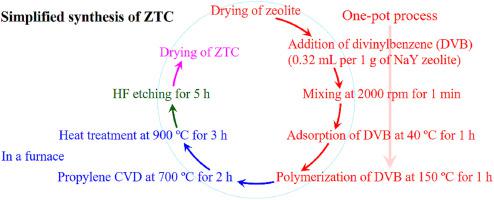Microporous and Mesoporous Materials ( IF 5.2 ) Pub Date : 2021-08-19 , DOI: 10.1016/j.micromeso.2021.111378 Hiroyuki Itoi 1 , Yuto Kasai 1 , Keita Morishita 1 , Ryutaro Suzuki 1 , Yuka Gotoh 1 , Chika Matsuoka 1 , Masahiro Miyaji 1 , Rikuto Hirade 1 , Yuichiro Tanabe 1 , Hiroyuki Iwata 2 , Yoshimi Ohzawa 1

|
Zeolite-templated carbon (ZTC) with a high surface area of 3860 m2 g−1 is readily synthesized from divinylbenzene (DVB) and propylene as carbon sources, by using NaY zeolite as a template. In the present method, the necessary amount of DVB can be reduced to the total pore volume of the zeolite. DVB can be directly mixed with previously dried zeolite, and each time for the adsorption and the thermal polymerization of DVB is shortened to only 1 h. The resulting NaY/polydivinylbenzene (PDVB) is subject to chemical vapor deposition (CVD) using propylene and the subsequent carbonization. In this process, DVB becomes graphene fragments that have a catalytic activity against propylene, and the ZTC framework with the three-dimensionally ordered and interconnected micropore structure is developed inside the zeolite pores during the CVD. Finally, zeolite is removed by HF etching, producing 0.3 g of ZTC per 1 g of zeolite. Instead of DVB, previous methods to prepare high surface area ZTCs use furfuryl alcohol that gradually polymerizes and strongly stacks on the zeolite particles, leading to a decrease in the surface area of ZTC due to the resulting nonporous carbon shell formed on the ZTC particles. The present method is much easier and more feasible than the previous methods, and does not require any reagents for polymerizing DVB or organic solvents.
中文翻译:

使用二乙烯基苯和丙烯作为碳源的高表面积沸石模板碳的简便合成
具有 3860 m 2 g -1高表面积的沸石模板碳 (ZTC)以二乙烯基苯 (DVB) 和丙烯为碳源,以 NaY 沸石为模板,很容易合成。在本方法中,DVB的必要量可以减少到沸石的总孔体积。DVB可直接与预先干燥的沸石混合,每次吸附和热聚合DVB的时间缩短至仅1小时。所得的 NaY/聚二乙烯基苯 (PDVB) 使用丙烯进行化学气相沉积 (CVD),然后进行碳化。在这个过程中,DVB变成了对丙烯具有催化活性的石墨烯碎片,在CVD过程中,在沸石孔隙内部形成了具有三维有序和相互连接的微孔结构的ZTC骨架。最后,通过 HF 蚀刻去除沸石,每 1 克沸石产生 0.3 克 ZTC。以前制备高表面积 ZTC 的方法不是 DVB,而是使用逐渐聚合并强烈堆积在沸石颗粒上的糠醇,由于在 ZTC 颗粒上形成无孔碳壳,导致 ZTC 的表面积减小。本方法比以前的方法更容易和更可行,并且不需要任何用于聚合 DVB 的试剂或有机溶剂。


























 京公网安备 11010802027423号
京公网安备 11010802027423号